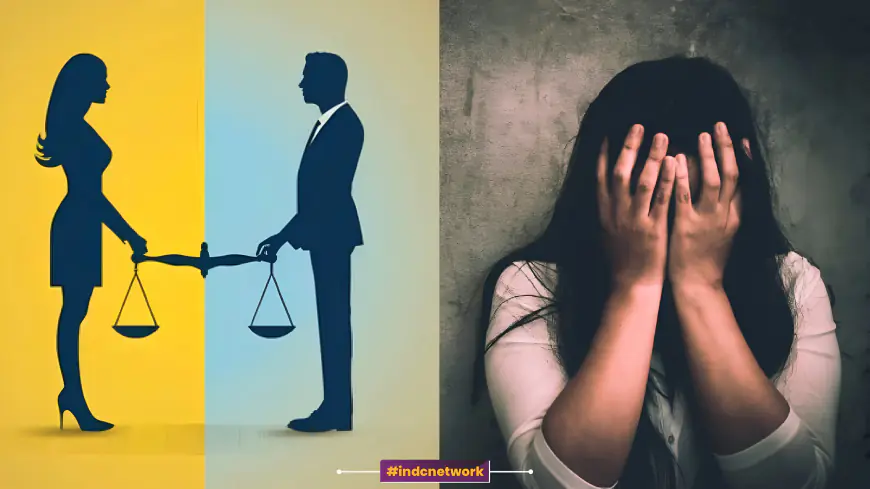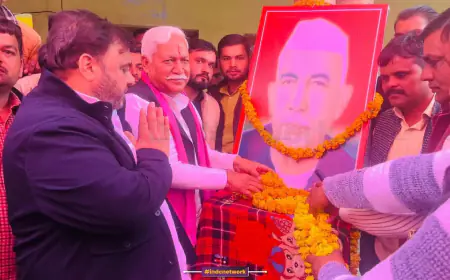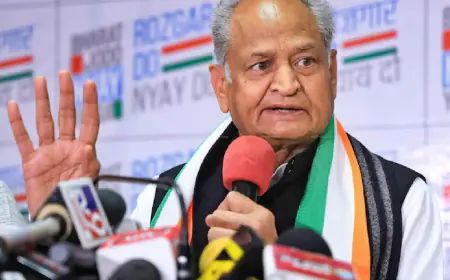Social Issue : Gender Inequality and Women's Safety in India: Challenges, Progress, and the Road Ahead
This article explores the persistent issues of gender inequality and women's safety in India, highlighting the historical context, current challenges in education, employment, and violence against women. It discusses government initiatives, legal reforms, societal attitudes, and the role of education and media in promoting gender equality. The article also outlines the steps needed to create a safer, more equitable society for women, emphasizing the importance of strengthening legal protections, changing societal norms, and empowering women and girls.

INDC Network : Social Issues : Gender Inequality and Women's Safety in India: Challenges, Progress, and the Road Ahead
Gender inequality and women's safety are pressing social issues in India, deeply rooted in the country's history, culture, and socio-economic structures. Despite significant strides toward gender equality, pervasive discrimination and violence against women remain critical challenges. This article explores the multifaceted nature of gender inequality and women's safety in India, examines the progress made, and discusses the steps needed to create a safer, more equitable society for women.
Historical Context and Cultural Influences : Gender inequality in India is deeply entrenched, with its roots in patriarchal traditions that have long dictated the roles and status of women in society. Historically, women were often confined to domestic roles, while men dominated public life and decision-making processes. Practices such as dowry, child marriage, and sati (the burning of widows) are stark reminders of the oppressive norms that once governed women's lives.
Although many of these practices have been abolished or significantly reduced, the legacy of patriarchy continues to influence contemporary gender dynamics. Cultural norms and societal expectations still dictate that women should prioritize family and household responsibilities over personal and professional ambitions. These deeply ingrained beliefs perpetuate gender inequality and limit opportunities for women in various spheres of life.
Gender Inequality in Education and Employment : Education and employment are two key areas where gender inequality is most visible in India. Although there has been considerable progress in increasing female literacy rates and enrollment in schools, significant disparities remain. According to the National Statistical Office (NSO), the female literacy rate in India was 70.3% in 2017-18, compared to 84.7% for males. This gap is particularly pronounced in rural areas, where girls are often denied education due to poverty, cultural norms, and safety concerns.
The impact of limited education is evident in the labor market, where women are underrepresented and often relegated to low-paying, informal jobs. According to the Periodic Labour Force Survey (PLFS) 2019-20, the labor force participation rate for women in India was only 18.6%, compared to 55.6% for men. Women are more likely to be employed in unorganized sectors, such as agriculture and domestic work, where they have little job security, benefits, or protections.
Even when women enter formal employment, they face significant barriers, including wage disparities, limited access to leadership positions, and workplace harassment. The gender pay gap in India remains substantial, with women earning, on average, 19% less than men for the same work. This gap is exacerbated by the "glass ceiling" effect, where women are underrepresented in senior management and leadership roles.
Violence Against Women: A Grave Concern :
One of the most pressing issues related to gender inequality in India is the prevalence of violence against women. This violence manifests in various forms, including domestic abuse, sexual harassment, rape, dowry-related violence, and honor killings. The National Crime Records Bureau (NCRB) reported over 4 lakh crimes against women in 2019, a number that likely underrepresents the true extent of the problem due to underreporting.
Domestic violence is one of the most widespread forms of violence against women in India. The National Family Health Survey (NFHS-5) found that 30% of women aged 15-49 had experienced physical violence since the age of 15. Despite the passage of the Protection of Women from Domestic Violence Act in 2005, which aimed to provide legal recourse and protection for victims, many women continue to suffer in silence due to social stigma, fear of retaliation, and lack of awareness about their rights.
Sexual violence is another grave concern, with cases of rape and sexual assault frequently making headlines. The brutal gang rape and murder of a young woman in Delhi in 2012, known as the Nirbhaya case, sparked nationwide protests and led to significant legal reforms, including the Criminal Law (Amendment) Act of 2013. However, despite these changes, sexual violence remains rampant. The NCRB recorded 32,033 cases of rape in 2019, or about 88 cases per day. The actual numbers are likely higher, as many victims do not report their experiences due to fear, shame, or distrust in the legal system.
Sexual harassment in public spaces and workplaces also poses a significant threat to women's safety. The Sexual Harassment of Women at Workplace (Prevention, Prohibition, and Redressal) Act of 2013 was enacted to address this issue, but implementation remains uneven. Many women, especially in the informal sector, are unaware of the protections available to them or fear retaliation if they speak out.
Government Initiatives and Legal Reforms : Recognizing the gravity of gender inequality and violence against women, the Indian government has implemented various policies, legal reforms, and initiatives aimed at addressing these issues. The Beti Bachao Beti Padhao (Save the Girl Child, Educate the Girl Child) campaign, launched in 2015, aims to improve the welfare of girls by addressing gender-biased sex selection and promoting girls' education.
The government has also introduced schemes like Sukanya Samriddhi Yojana, which encourages parents to save for their daughters' education and marriage, and the Pradhan Mantri Ujjwala Yojana, which provides free LPG connections to women in rural areas to reduce their exposure to health hazards from traditional cooking methods.
Legal reforms have also been enacted to protect women from violence and discrimination. The Criminal Law (Amendment) Act of 2013, passed in the wake of the Nirbhaya case, expanded the definition of rape, increased penalties for sexual offenses, and introduced new offenses such as stalking and acid attacks. The POCSO (Protection of Children from Sexual Offenses) Act of 2012 was also strengthened to protect minors from sexual abuse.
Despite these efforts, challenges remain in implementing these laws and ensuring that they effectively protect women. Many women, particularly in rural areas, are unaware of their legal rights, and even when they are aware, accessing justice can be difficult due to systemic barriers such as police apathy, judicial delays, and societal pressure to maintain silence.
Societal Attitudes and the Role of Media : One of the most significant barriers to achieving gender equality and ensuring women's safety in India is the persistence of patriarchal attitudes and societal norms that devalue women. These attitudes are often reinforced by media portrayals of women, which frequently depict them in stereotypical roles or objectify them.
The media plays a crucial role in shaping public perceptions and attitudes towards gender roles. While there has been some progress in recent years, with more positive portrayals of women in leadership roles and as agents of change, much work remains to be done. Television shows, films, and advertisements still often reinforce traditional gender roles, portraying women as submissive, dependent, or primarily concerned with their appearance.
The normalization of violence against women in media, particularly in films and television, also contributes to the perpetuation of harmful attitudes. The glamorization of stalking, harassment, and even rape in popular culture sends dangerous messages that such behavior is acceptable or even desirable.
However, the media can also be a powerful tool for change. Campaigns like the #MeToo movement, which gained traction in India in 2018, have used social media to give voice to survivors of sexual harassment and assault, challenging the culture of silence and impunity. These movements have sparked important conversations about gender equality and women's rights, highlighting the need for societal change.
The Role of Education and Awareness : Education is a key driver of change in the fight against gender inequality and violence against women. By educating both boys and girls about gender equality, respect for women, and the importance of consent, society can begin to challenge and dismantle the patriarchal norms that underpin discrimination and violence.
Gender-sensitive education, which includes comprehensive sex education, can play a vital role in changing attitudes and behaviors. Schools and colleges should incorporate gender equality into their curricula, teaching students about the importance of equal rights and opportunities for all, regardless of gender. Additionally, raising awareness about legal protections and resources available to women can empower them to assert their rights and seek justice.
Community-based programs and initiatives can also play a significant role in challenging harmful gender norms and promoting women's safety. Grassroots organizations, often led by women themselves, have been at the forefront of efforts to combat violence against women and promote gender equality in India. These organizations work to raise awareness, provide support services to survivors, and advocate for policy changes.
The Way Forward: Building a Safer, More Equitable Society :
While progress has been made in addressing gender inequality and improving women's safety in India, significant challenges remain. To build a safer, more equitable society, a multifaceted approach is needed that addresses the root causes of gender inequality and violence against women.
-
Strengthening Legal Protections: Existing laws must be rigorously enforced, and legal loopholes closed to ensure that perpetrators of violence against women are held accountable. This includes improving the responsiveness of the police and judiciary, providing better support services for survivors, and ensuring that women have access to justice, particularly in rural areas.
-
Changing Societal Attitudes: Efforts to change societal attitudes towards women and gender roles must be intensified. This includes media campaigns that challenge stereotypes, promote positive portrayals of women, and raise awareness about gender-based violence. Engaging men and boys in these efforts is crucial, as they play a key role in challenging and changing patriarchal norms.
-
Promoting Gender Equality in Education and Employment: To achieve true gender equality, efforts must be made to ensure that girls and women have equal access to education and employment opportunities. This includes addressing barriers such as poverty, safety concerns, and cultural norms that prevent girls from attending school or women from entering the workforce.
-
Empowering Women and Girls: Empowering women and girls to assert their rights and make their own decisions is key to achieving gender equality. This can be done through education, awareness campaigns, and providing women with the resources and support they need to succeed in all aspects of life.
-
Engaging Communities: Community-based initiatives that involve local leaders, families, and grassroots organizations can be effective in challenging harmful gender norms and promoting women's safety. These initiatives should be supported and scaled up to reach more communities across India.
-
Leveraging Technology: Technology can be a powerful tool in promoting women's safety and empowerment. Mobile apps, helplines, and online platforms can provide women with access to information, resources, and support, as well as help them report incidents of violence and seek help.
Conclusion : Gender inequality and women's safety are deeply interconnected issues that require a comprehensive and sustained effort to address. While progress has been made, there is still much work to be done to ensure that all women in India can live free from discrimination, violence, and fear. By strengthening legal protections, challenging societal attitudes, promoting gender equality in education and employment, empowering women, engaging communities, and leveraging technology, India can move closer to achieving true gender equality and creating a safer, more equitable society for all.
What's Your Reaction?













































































































































































